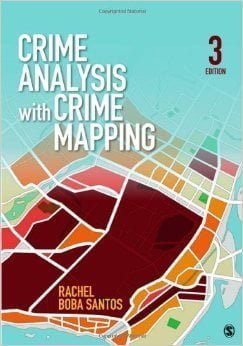Test Bank For Crime Analysis With Crime Mapping Paperback 3rd edition by Rachel Boba Santos
$35.00 Original price was: $35.00.$26.50Current price is: $26.50.
Test Bank For Crime Analysis With Crime Mapping Paperback 3rd edition by Rachel Boba Santos
Instant download Crime Analysis With Crime Mapping Paperback 3rd edition by Rachel Boba Santos pdf docx epub after payment.

CHAPTER 1: CRIME ANALYSIS AND THE PROFESSION
TEST BANK
MULTIPLE CHOICE
Crime analysis is
a. The study of crime statistics
b. The systematic study of crime and disorder problems to assist the police
c. Research conducted by academics to understand the nature of crime
d. The study of the geographic nature of crime
Crime analysts use qualitative data and methods
a. To develop forecasts for future crime events
b. To conduct statistics on frequency of crime
c. To examine nonnumerical data for the purpose of discovering underlying meanings and patterns of relationships
d. To understand the correlational relationships between types of crime
Crime analysts use quantitative data and methods
a. To conduct statistical analysis of numerical or categorical data
b. To identify short term patterns of crime
c. To develop profiles for serial criminals
d. To link organized criminal networks
The central focus of crime analysis is
a. Assisting with resource allocation and staffing
b. Understanding the geographical nature of crime
c. The study of crime and disorder problems
d. Providing information to citizens about crime
The four purposes of crime analysis are
a. To assist the police in criminal apprehension, victim assistance, crime reduction, and crime prevention
b. To assist the police in crime and disorder reduction, crime prevention, evaluation, and research
c. To assist the police in research, evaluation, presentations, and statistical reports
d. To assist the police in criminal apprehension, crime and disorder reduction, crime prevention, and evaluation
A geographic information system (GIS) is all of the following EXCEPT:
a. A powerful software tool that allows the user to create any kind of geographic representation
b. A set of computer-based tools that allows the user to modify, visualize, query, and analyze geographic and tabular data
c. Similar to a spreadsheet or word processing program in that the software provides a framework and templates for data collection, collation, and analysis
d. A unstructured collection of records or data that is stored in a computer so that a crime analyst can consult it to answer queries
Crime mapping is
a. The process of using a geographic information system to conduct spatial analysis of crime problems and other police-related issues
b. The discipline concerned with the development, use, application and influence of information technologies
c. The study and practice of making maps
d. A system for capturing, storing, analyzing and managing data and associated attributes which are spatially referenced to the earth
Which of the follow are the main functions of crime mapping within crime analysis:
1) It facilitates visual and statistical analyses of the spatial nature of crime and other types of events.
2) It allows analysts to link data together based on common geographic variables
3) It provides maps that help to communicate analysis results
4) It helps officers find call for service and crime locations while on patrol
a. 1 and 2
b. 1, 2, and 3
c. 1, 2, 3 and 4
d. 1 and 3
The history of crime analysis as a discipline begins with
a. The New York City Police Department in the early 1900s
b. Farmers and ranchers looking out for their livestock
c. Professors in the School of Cartography
d. The first modern police force in London in the early 19th century
The first indication of formal crime analysis in the United States is found in
a. The early 1900s
b. The late 1960s
c. The 1970s
d. The mid 1800s
Which brought about increased awareness of the use of analysis and evaluation in policing throughout the 1970s?
a. Violent Crime Control and Law Enforcement Act of 1994
b. 1968 Omnibus Crime Control and Safe Streets Act
c. 1975 Crime Analysis and Evaluation Act
d. None of the above
Which of the following did NOT influence crime analysis in the mid- to late 1970s,
a. Academics emphasizing the importance of criminal events vs. criminality of individuals
b. The geographic analysis of crime
c. Commission on Accreditation for Law Enforcement Agencies (CALEA)
d. New York City’s COMPSTAT
The IACA is
a. The International Alliance of Criminal Analysis
b. The Interstate Association of Crime Analysis
c. The International Association of Crime Analysts
d. The Intelligence and Crime Analysis Association
Which of the following DID NOT influence crime analysis in the 1990s
a. Community policing and problem-oriented policing
b. Improved computer technology
c. New York City’s Compstat
d. A shortage of individuals wanting to be police officers
e. Funding from the COPS office
Crime mapping began
a. With researchers in the 1970s who emphasized crime and place
b. With European researchers who examined the levels of crime within different regions and the relationship of these levels to sociological factors
c. In the London Metropolitan Police Department
d. In the US in the early 1900s
The following is one of the reasons crime mapping started later in the US than in Europe.
a. The US did not have scholars capable of conducting crime mapping
b. The US was a relatively new country and reliable maps were not readily available
c. Europe’s technology was much more advanced earlier than the US
d. None of the above
Crime mapping was a very important component of the development of which criminology theoretical tradition:
a. Criminal analysis theory
b. Social disorganization theory
c. Differential association theory
d. Geographic information theory
In the 1970s, what had a large impact on the development of crime mapping:
a. Significant improvements in data and technology
b. Significant grant funding
c. The shift of focus from the criminal to the criminal event
d. Problem-oriented policing
Which impacted crime mapping in the 1990s?
a. Significant improvements in computer technology and police data systems
b. Federal funding
c. Geographic data such as street and census information became widely available in electronic format
d. All of the above
A person who works within a crime analysis unit, unpaid, and gets college credit for doing so is a/an:
a. Volunteer
b. Crime analysis technician
c. Intern
d. Student worker
In the crime analysis unit, this person would assist with data entry and produce standardized reports.
a. Crime analysis assistant
b. Entry level crime analyst
c. Secretary
d. File clerk
In a crime analysis unit, this person would direct and oversee the direction and work of the unit.
a. Entry-level crime analyst
b. Experienced crime analyst
c. Crime analysis supervisor
d. Commander of the crime analysis unit
Examples of specialty crime analyst include all BUT:
a. Problem analyst
b. Burglary analyst
c. School safety analyst
d. Information systems analyst
TRUE/FALSE
T Crime analysis is not haphazard or anecdotal; rather, it involves the application of data collection procedures, analytic methods, and statistical techniques.
F Crime analysis entails primarily the study of criminal incidents and offenders.
T Temporal, spatial, and sociodemographic factors are key areas of focus in crime analysts’ examinations of crime, disorder, and other police-related issues.
F The goals of crime analysis are to assist police in criminal apprehension, crime mapping, crime prevention, and research that tests theory.
F Crime analysis began in the United States in the 1820s.
F The first professional associations concerned with crime analysis were established in the late 1990s.
T The U.S. government’s emphasis on community policing and problem solving led to the availability of federal grants that enabled police agencies to implement crime analysis.
F Crime analysis is mostly conducted in small police agencies in the United States.
T The beginnings of crime mapping are different from the beginnings of crime analysis in that crime mapping began through the work of researchers in the 1800s and the early 1900s.
F The first substantive spatial analysis of crime in Europe was conducted in the 1920s and 1930s by urban sociologists.
T Scholars’ focus on the geographic analysis of criminal events and problem-oriented policing increased attention to crime analysis in the 1970s and 1980s.
T Implementation of Compstat in police agencies across the United States fueled the rapid adoption of crime mapping in the mid- to late 1990s.
T Currently, most large police agencies use some form of crime mapping.
F Crime mapping positions in police departments are nearly always part of the crime analysis unit, but are paid somewhat lower than crime analysts.
ESSAY QUESTIONS
Describe the evolution of crime analysis in the United States from 1900 to now.
Discuss two ways in which the history of crime analysis and crime mapping have followed different paths.
You may also like…
Solution Manual
Test Bank
Test Bank for Computer Forensics and Cyber Crime An Introduction 3rd Edition Marjie T Britz Download












